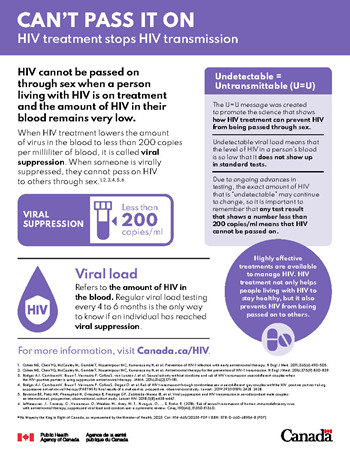Can’t pass it on: HIV treatment prevents transmission (fact sheet)

Download the alternative format
(PDF format, 128 KB, 1 page)
Please select a language:
HIV cannot be passed on through sex when a person living with HIV is on treatment and the amount of HIV in their blood remains very low.
When HIV treatment lowers the amount of virus in the blood to less than 200 copies per millilitre of blood, it is called viral suppression. When someone is virally suppressed, they cannot pass on HIV to others through sex.Footnote 1Footnote 2Footnote 3Footnote 4Footnote 5Footnote 6
- Viral suppression: Less than 200 copies/ml
- Viral load: Refers to the amount of HIV in the blood. Regular viral load testing every 4 to 6 months is the only way to know if an individual has reached viral suppression.
Undetectable = Untransmittable (U=U)
- The U=U message was created to promote the science that shows how HIV treatment can prevent HIV from being passed through sex.
- Undetectable viral load means that the level of HIV in a person’s blood is so low that it does not show up in standard tests.
- Due to ongoing advances in testing, the exact amount of HIV that is “undetectable” may continue to change, so it is important to remember that any test result that shows a number less than 200 copies/ml means that HIV cannot be passed on.
Highly effective treatments are available to manage HIV. HIV treatment not only helps people living with HIV to stay healthy, but it also prevents HIV from being passed on to others.
For more information, visit Canada.ca/HIV.
Footnotes
- Footnote 1
-
Cohen MS, Chen YQ, McCauley M, Gamble T, Hosseinipour MC, Kumarasamy N, et al. Prevention of HIV-1 infection with early antiretroviral therapy. N Engl J Med. 2011;365(6):493-505.
- Footnote 2
-
Cohen MS, Chen YQ, McCauley M, Gamble T, Hosseinipour MC, Kumarasamy N, et al. Antiretroviral therapy for the prevention of HIV-1 transmission. N Engl J Med. 2016;375(9):830-839.
- Footnote 3
-
Rodger AJ, Cambiano V, Bruun T, Vernazza P, Collins S, van Lunzen J, et al. Sexual activity without condoms and risk of HIV transmission in serodifferent couples when the HIV-positive partner is using suppressive antiretroviral therapy. JAMA. 2016;316(2):171-181.
- Footnote 4
-
Rodger AJ, Cambiano V, Bruun T, Vernazza P, Collins S, Degen O, et al. Risk of HIV transmission through condomless sex in serodifferent gay couples with the HIV-positive partner taking suppressive antiretroviral therapy (PARTNER): final results of a multicentre, prospective, observational study. Lancet. 2019;393(10189):2428-2438.
- Footnote 5
-
Bavinton BR, Pinto AN, Phanuphak N, Grinsztejn B, Prestage GP, Zablotska-Manos IB, et al. Viral suppression and HIV transmission in serodiscordant male couples: an international, prospective, observational, cohort study. Lancet HIV. 2018;5(8):e438-e447.
- Footnote 6
-
LeMessurier, J., Traversy, G., Varsaneux, O., Weekes, M., Avey, M. T., Niragira, O., ... & Rodin, R. (2018). Risk of sexual transmission of human immunodeficiency virus with antiretroviral therapy, suppressed viral load and condom use: a systematic review. Cmaj, 190(46), E1350-E1360.